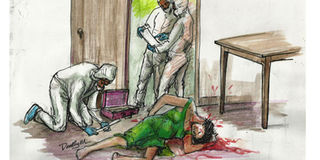What is a forensic postmortem?

The results of the postmortem examination will be used to show that death was not from natural causes and that it may not have been accidental.
What you need to know:
Part II. Besides establishing the time of death, a medico-legal or forensic postmortem also helps establush the cause of death and whether it was intentional or not.
It usually takes up to four hours for the stomach to empty food into the intestines. This fact is used by forensic pathologists to estimate the time of death of a person, especially when the last time a person had a meal is known. For a person found dead in bed, the finding of a full stomach means that death occurred within four hours of having taken that meal. And the finding of an empty stomach means that death occurred probably four hours after the last meal.
When a person dies, the heart ceases to pump blood. The blood in the body then gravitates to the blood vessels in the most dependant parts of the body and causes the discoloration of those parts. This discoloration takes up to eight hours to occur and, therefore, its rate can also be used to estimate the time when death occurred. This discoloration does not occur in places where there is pressure on the body. These may be areas of the ground or objects the body is in contact with.
An abnormal pattern of discoloration, inconsistent with the position in which a body is found suggests that the body may have been tampered with. Further confirmation of this is the finding of abnormal stiffening of the body, relative to the natural position of the body at the time of death.
Crime scene investigation
It is for this reason that the scene where a body is discovered should not tampered with until all the evidence is gathered, especially by the Scenes of Crime Officers of the Police. Such evidence includes photographs of the body and scene. It is said that a photograph will say what a thousand words may not say.
A lot of evidence, including trace evidence may be recovered from a crime scene. A careful observation of the blood spatter pattern will indicate whether death occurred in that place or from another place. In addition, an assailant will always leave some evidence at the crime scene or take some evidence from the crime scene.
A scene of discovery of a body can also be used to determine if such a death was a suicide, homicide or accidental. In case of suicides, there may be a suicide note, a weapon gripped in the hands of the victim or close by, and no evidence of a struggle. The injuries sustained in suicides are also typical.
However, in deaths due to homicides, the injuries may be multiple and/or in places not accessible to the individual. In addition, there may be injuries sustained by the deceased while defending himself or herself and these are known as defense injuries. There may also be features of a struggle at the scene where the body was discovered.
Cause of death
One of the purposes of a postmortem examination is to establish the cause of death. The prosecution uses this fact in court to prove that a death was unlawful, one of the ingredients of the offence of murder or manslaughter. In this, the results of the postmortem examination will be used to show that death was not from natural causes and that it may not have been accidental.
To further prove a case of murder, the prosecution must establish evidence of the intention of the accused, that is, a deliberate intention to cause death.
A forensic postmortem examination will determine the nature of weapon used on the deceased and how the weapon was used to cause death and the part of the body targeted by the assailant. The use of a deadly weapon such as a gun may construe a deliberate intention to cause death, especially if there are multiple injuries caused by the assailant.
Multiple stab wounds in venerable areas of the body such as the neck and chest will also point to a deliberate effort to cause death. A postmortem examination should be used to reconstruct the events that preceded the death and this is important in demonstrating ill intention.
Matching DNA
On the body a lot of evidence of forensic importance can be obtained. In forensic mortuaries, it is standard practice to remove tissues from the deceased for DNA analysis. This helps to match the DNA of the deceased with blood or other body tissues recovered from a weapon or another scene. The DNA of the assailant may also be found from blood stains on the clothes of the deceased or from fingernail clippings removed from the deceased in case of a fight between the deceased and the assailant.
In case of victims of gun-shot injuries, explosive injuries, or fires, a whole body X-ray is routinely performed. Bullets and other fragments of explosives recovered from such bodies are sent to specialised labs so as to determine the source of these and link them to the weapon that discharged these fragments.
A review of the postmortem examination by colleagues before the findings are issued out is standard practice in almost all standard forensic mortuaries. Such reviews are excellent quality control measures and are useful tools to audit forensic postmortems examinations.



